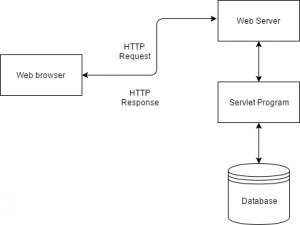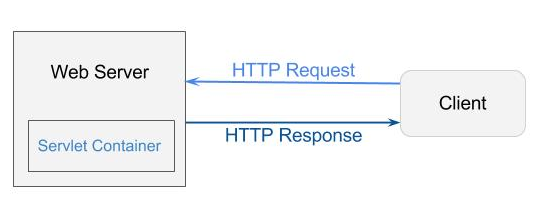Introduction to Java Servlets
 Harshal Rembhotkar
Harshal RembhotkarTable of contents
- Introduction to Java Servlets:
- You can understand the Servlet Architecture by looking at the provided image below.
- Execution of Servlets basically involves 6 steps:
- Why do we need for server- side extensions ?
- What is CGI?
- Benefits of Java Servlet:
- Servlet Container:
- The Servlet container offers various services:
- What is a Servlet Filter?
- Conclusion:

Introduction to Java Servlets:
Nowadays, we know it's important to make web pages that can change content based on the time or what the user wants. If you like using Java for coding, here's a cool thing: Java Servlets help you create dynamic web pages. But before we get into that, let's talk about why we need server-side extensions.
Servlets are like special Java programs that work on Java-enabled web servers. They deal with requests from the web server, do some processing, create a response, and send it back to the web server.
The main properties of Servlets are as follows below:
Servlets work on the server side.
Servlets are capable of handling complex requests obtained from the web server.
You can understand the Servlet Architecture by looking at the provided image below.

Execution of Servlets basically involves 6 steps:
The clients send the request to the webserver.
The web server receives the request.
The web server passes the request to the corresponding servlet.
The servlet processes the request and generates the response in the form of output.
The servlet sends the response back to the webserver.
6. The web server sends the response back to the client and the client browser displays it on the screen.
Why do we need for server- side extensions ?
Let's discuss the importance of server-side extensions. These are technologies used to create dynamic web pages. Dynamic web pages need a container or web server, and different providers offer solutions through APIs (Application Programming Interface). APIs enable the creation of programs running on a web server. Java Servlet, part of Jakarta EE, sets standards for dynamic web applications in Java.
There are various technologies for dynamic web pages, and Servlet is just one, similar to other extensions like CGI scripts and PHP.
What is CGI?
CGI is actually an external application that is written by using any of the programming languages like C, etc. and this is responsible for processing client requests and generating dynamic content.
So, in CGI server has to create and destroy the process for every request. It’s easy to understand that this approach is applicable for handling few clients but as the number of clients increases, the workload on the server increases and so the time is taken to process requests increases.
| Servlet | CGI (Common Gateway Interface) |
| Servlets are portable and efficient. | CGI is not portable. |
| In Servlets, sharing data is possible. | In CGI, sharing data is not possible. |
| Servlets can directly communicate with the webserver. | CGI cannot directly communicate with the webserver. |
| Servlets can handle the cookies. | CGI cannot handle the cookies. |
Benefits of Java Servlet:
Faster Processing: Servlets are quicker than CGI because they don't create a new process for every request. This speeds up handling requests.
Platform Independence: Since Servlets are written in Java, they work on different platforms without any issues. They're not picky about which operating system they run on.
Efficient Resource Usage: Unlike some methods that create a new process for each request, Servlets use a single instance to handle all requests simultaneously. This saves memory and makes it easier for a Servlet to manage client interactions.
Security Inheritance: As a server-side component, Servlets inherit the security features provided by the web server, adding an extra layer of protection.
Automatic Platform Advantages: The Java Servlet API automatically leverages the benefits of the Java platform, such as platform independence and portability. It can also make use of various Java APIs, like JDBC for database access.
Cost-Effective Options: Many web servers suitable for personal or low-traffic websites, like Java Servlet, are available for free or at very affordable prices. While most high-grade commercial web servers tend to be expensive, Apache is a notable exception, being free of charge.
Servlet Container:
The Servlet Container, also called the Servlet engine, is like a team of tools that creates a place for Java Servlets to work. In easy terms, it's a system that takes care of Java Servlets on the web server, making sure they can handle requests from web clients. It's like a manager for Java Servlets in the web world.

The Servlet container offers various services:
Network Services: It loads a Servlet class, whether it's from a local file system, a remote file system, or other network services. The Servlet container takes care of the network services for sending and receiving requests and responses.
Decode and Encode MIME-based Messages: The container helps in understanding and creating MIME-based messages, which are a way of formatting information.
Manage Servlet Lifecycle: It looks after the different stages of a Servlet's life, making sure it starts and stops when needed.
Resource Management: Handles static and dynamic resources like HTML files, Servlets, and JSP pages. It ensures these resources are available and ready to use.
Security Services: Takes care of authorizing and authenticating access to resources, adding a layer of security to the web applications.
Session Management: Maintains a session by adding a session ID to the URL path. This is how it keeps track of users and their interactions.
What is a Servlet Filter?
Think of a servlet filter as an extra helper for handling tasks before or after a web request. it does things like logging ,monitoring ,debugging , and troubleshooting to make sure everything works smoothly on the web .it's like a handy assistant for managing and checking web requests.
Conclusion:
In conclusion, Java Servlets play a vital role in managing business logic and handling intricate web requests. They contribute significantly to the dynamic evolution of websites, offering the potential to reshape how applications work. Here are the key takeaways. Java Servlets are instrumental in server-side application development, providing a robust approach to dealing with dynamic content and enhancing the creation of interactive websites.When a request hits the web server, a servlet instance kicks in through the init() method. The HTTP request is then managed based on its type, utilizing doGet() or doPost() methods.Servlets enhance web application responsiveness and efficiency. Unlike processes that are created and destroyed with each request, servlets remain active, contributing to a more streamlined operation.
Subscribe to my newsletter
Read articles from Harshal Rembhotkar directly inside your inbox. Subscribe to the newsletter, and don't miss out.
Written by

Harshal Rembhotkar
Harshal Rembhotkar
I do Dev, I do Ops, and I do it (most days).